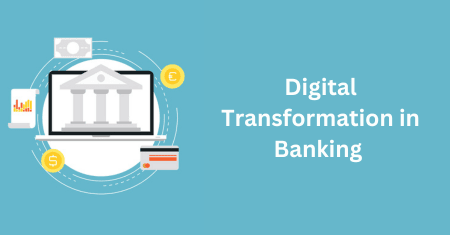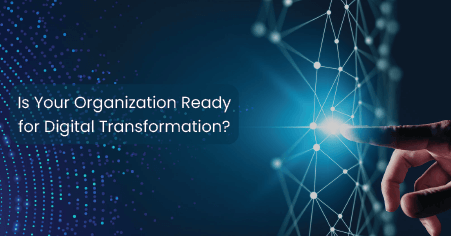
23 May Digital Transformation in Banking – Impact on Businesses
23 May 2023

Digital transformation in banking is a significant shift that goes beyond merely transitioning from traditional to digital operations. It encompasses how banks and financial institutions analyze, interact with, and meet the needs of their customers. The focus has shifted from a product-centric approach to a customer-centric one, intending to deliver the best customer experience.
According to a report by MarketsandMarkets, the global digital banking platform market is expected to reach USD 13.9 billion by 2026, growing at a CAGR of 11.3%. This growth is driven by the increasing demand for improved customer experiences and the adoption of cloud technologies by banks. Statista predicts that by 2024, approximately 2.5 billion individuals will be utilizing online banking services.
Digital transformation in banking involves various aspects, such as the development of online banking applications, data encryption software, virtual assistants, KYC system software, and website optimization. This transformation raises numerous questions about the digitization of banks and similar institutions.
To understand this, let’s examine how the shift from traditional to digital banking began
Banks initiated their digital banking journey several years ago, recognizing that most of their customers were already using digital channels. They implemented digital strategies from the top down, making the banking sector more customer-focused and technologically adept. The transition to digital platforms saw a significant emphasis on mobile banking, as customers increasingly used mobile applications and websites for transactions.
To keep up with the evolving market, traditional banks had to adapt to new technologies and operating models that supported the entire customer journey. The growth and demand for technologies like Artificial Intelligence (AI), blockchain, and the Internet of Things (IoT) accelerated the modernization of the banking industry. Today, banks heavily rely on omnichannel strategies to enhance the customer experience by breaking data silos across different channels.
Digital transformation has helped financial service providers improve efficiency, drive growth, and enhance convenience for their customers, thereby attracting new prospects.
Read More: Digital transformation in different industries
Several key factors drive this transformation in banking and financial services:
Importance of customers: Banks migrate to digital platforms because that’s where their customers are. Digital approaches focus on meeting customer needs and expectations through personalized experiences, seamless queries, transparency, and security.
Operating model: Banks adopt three different operating models to meet customer expectations – digital as a business (management level), digital as the new line of business (separate digital division), and digital native (technology-focused setup directly serving consumers).
Modernized infrastructure: Upgrading legacy infrastructure is crucial for enabling digital transformation in banking. The modern infrastructure supports efficient data management and enables front-end operations.
The power of data: Banks harness the power of consumer data to analyze customer patterns and deliver relevant products and services aligned with their needs. Data analytics plays a vital role in understanding customer behavior and driving innovation.
Complete digitally driven market: The entire consumer market is embracing digital capabilities, which influences banking and financial institutions to undergo digital transformation.
Digital technologies play a crucial role in the transformation of banking. Some of the major tools and technologies utilized by modern banks include:
Artificial Intelligence (AI) and Machine Learning (ML): AI-powered chatbots resolve customer queries and assist with data analysis, management, and enhancing the customer experience. Machine learning aids in fraud detection and real-time user data comparison.
Internet of Things (IoT): IoT enables real-time data analysis, personalized customer experiences, and contactless payments while also introducing risk management and biometric sensors for authorization processes.
Blockchain: Blockchain ensures secure data transactions, accuracy, and transparency. The integration of blockchain with IoT (BIoT) has been a significant trend in digital banking.
Cloud computing and APIs: Cloud computing improves operations, productivity, and product/service delivery. Banks leverage banking APIs to enhance data sharing and the overall customer experience.
Big data analytics: Banks utilize big data analytics to analyze customer expenditures, monitor risks, and manage feedback, leading to increased customer loyalty and responsive market development.
Digital transformation in banking brings several benefits to the industry
Investment banking on a digital platform
Digital banking reduces intermediate processes, improves data transparency, and provides alternative methods for accessing financial information. This leads to lower operational costs, faster transactions, and the consolidation of small investors on centralized digital platforms.
Compliance
Digital financial management systems facilitate regulatory compliance through features such as automated auditing, standardized data, and seamless sharing across platforms. Banks can easily stay updated with regulatory changes, ensuring adherence to rules and regulations.
Easier acquisition of new customers
The digital transformation makes it easier and more cost-effective for banks and businesses to attract new customers. Instant online payments and seamless operations create a hassle-free experience, increasing customer acquisition and retention.
Business Innovation and Adaptability
Digital banking enables banks and businesses to leverage social channels, shopping portals, and mobile applications to reach customers and drive new business innovations. This reliance on banking services fuels innovation and supports the growth of digital enterprises.
Enhanced security
The integration of sophisticated software development services and technologies ensures improved customer data security, protecting accounts from scammers, hackers, and phishing attacks. Customers have greater trust in the security measures implemented by banks, enhancing their confidence in digital banking.
Personalized offerings
Digital transformation allows banks to tailor their products and services to individual customer needs. Through data analysis and understanding customer behavior, banks can offer personalized recommendations and targeted offers, enhancing the overall customer experience.
Conclusion
Digital transformation in banking represents a shift from traditional to customer-centric, digitally driven operations. It is driven by factors such as customer demands, operating models, modernized infrastructure, data analytics, a digitally driven market, and the adoption of digital technologies. This transformation brings numerous benefits to the banking industry, including improved efficiency, compliance, customer acquisition, business innovation, enhanced security, and personalized offerings.
Looking for the right digital vendors? Contact us for technology adoption guidelines and tailor-made digital solutions.
Our Related Posts
Digital transformation in different industries
Digital technologies are dramatically reshaping business structures and models in all aspects to meet market change and business requirements…
Empower digital workforce with Microsoft Viva
Today, the primary objective most organizations are focusing on is towards achieving people productivity, work smartly in digital workplaces…
Is Your Organization Ready for Digital Transformation?
Organizations got reality checked during this disruption and organizations being digitally equipped has a high priority to thrive in the new reality ….





No Comments